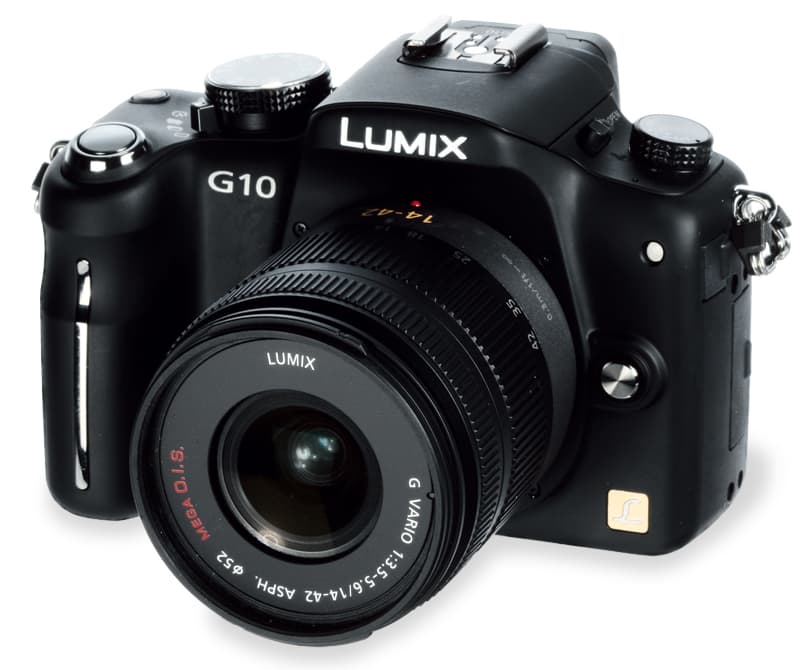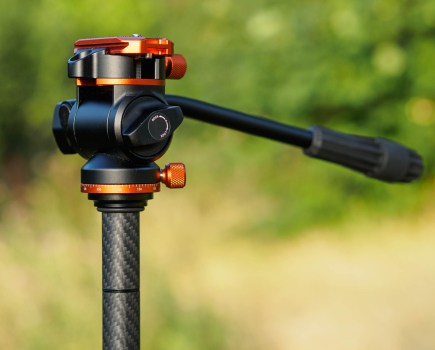Panasonic Lumix DMC-G10 Micro system camera at a glance:
- 12.1 million effective pixels
- Four Thirds Live MOS sensor
- Micro Four Thirds lens mount
- 1280×720-pixel video at 30fps
- Street price around £455 (with 14-42mm lens)
A recent AP online poll revealed that of the five Micro System Camera (MSC) systems currently available, AP website users have the most faith in Panasonic’s.
This is despite the fact that Olympus has a longer history in photography and that Ricoh, Samsung and Sony use larger (APS-C-sized) sensors rather than the 17.3x13mm Four Thirds-type device employed by Panasonic.
In its favour, though, Panasonic was the first manufacturer to enter the MSC market and, more importantly, it has proved that it can make decent small cameras that produce high-quality images.
Features
The Lumix DMC-G10 was announced at the same time as the Lumix DMC-G2, and is designed to be Panasonic’s most affordable MSC to date. Although it has the same mini-DSLR shape as the G2 (which replaced the Lumix DMC-G1), the G10 has a fixed LCD screen rather than an articulated unit.
Also, unlike the G2’s monitor, the G10’s screen isn’t touch sensitive, although it does offer a Live View of the scene. In addition, there’s a 202,000-dot (equivalent) electronic viewfinder (EVF) with a 100% field of view for composing images with the camera held to the eye. This is a lower resolution than the 1.44-million-dot unit of the G2 and G1, so it will be interesting to see how it performs.
Like Panasonic’s other MSCs, the G10 has a Four Thirds-type Live MOS sensor with 12.1 million effective pixels. Images may be saved as raw or JPEG files, or as both simultaneously. Images are processed using the G10’s Venus Engine HD II chip, which enables the camera to record JPEG files at 3.2fps or 2fps until the SD (or SDHC) card is full. In keeping with the current trend, the G10 can record 1280×720-pixel movie footage at 30fps.
With the exception of the lower resolution EVF and an articulated LCD, the G10 appears to offer just about everything that an enthusiast can hope for from a Micro System Camera, so perhaps it is the ideal choice for those on a budget. At present it is only sold as a kit with the new Lumix G Vario 14-42mm f/3.5-5.6 Asph Mega OIS lens.
Build and handling
Apart from it being slightly lighter, there is no discernible difference between the feel of the G10 and either the G1 or the G2 in the hand, and it appears just as well built. However, the control layout falls somewhere between the G1 and G2.
Like the newer G2, the G10 has a rear control dial above the thumb rest instead of a front dial, and there’s a button on the top-plate to activate iA (Intelligent Auto) mode, which is reached via the mode dial on the G1.
Unlike the G2, though, there’s no dedicated video-recording button and the G10’s mode dial must be rotated to its movie option and the shutter release used to start recording. The G10 also has the same method of setting the AF point selection mode as the G1, with a dial on the left of the top-plate setting the focus mode (single AF, continuous AF and manual) and the left navigation button providing a route to the point selection options. I prefer the top-plate-located switch-and-dial approach of the G2.
One feature of the G2 that I miss in the G10 is the eye sensor that automatically detects if the camera is held to the eye and switch between the EVF and LCD screen displays. I find it frustrating to have to keep pressing the EVF/LCD button to alternate between the two display options manually.
Resolution, noise and sensitivity
While DSLR manufacturers have been pushing sensitivity settings up so that ISO 12,800 (equivalent) is now becoming commonplace, Panasonic is a little more conservative with its MSCs and the G10 has a maximum setting of ISO 6400. This is the same as the G2 and a stop faster than the G1.
However, even at the lower sensitivity settings noise is visible in some even-toned areas. This doesn’t really become a problem until around ISO 1600. The shadows of raw images taken at this setting have quite a lot of chroma noise, with red speckling being particularly noticeable. Although the JPEG files captured with the standard level of in-camera noise reduction applied are smoother and have less colour noise visible, they contain a little less detail than the simultaneously recorded raw files.
Our resolution tests confirm that the G10’s resolution is on a par with the previous Panasonic G-series cameras we have tested, and in good light it can out-resolve some 12-million-pixel, APS-C-format DSLRs. The resolution chart images shown here were shot with the new G Vario 14-42mm f/3.5-5.6 Asph Mega OIS lens, indicating that it is another high performer.

These images show 72ppi (100% on a computer screen) sections of images of a resolution chart, captured using the kit lens set to 35mm (70mm equivalent). We show the section of the resolution chart where the camera starts to fail to reproduce the lines separately. The higher the number visible in these images, the better the camera’s detail resolution is at the specified sensitivity setting.
Dynamic range
One worry with Four Thirds and Micro Four Thirds cameras is that they often have a restricted dynamic range, but we have not found this to be the case with Panasonic’s G-series cameras, which have an impressive range of 11.5EV.
There are four options available for the G10’s dynamic range optimising Intelligent Exposure (iExposure) mode: Off, Low, Standard and High.
I used the highest setting during the majority of this test as the camera only applies the shadow brightening effect when it deems it necessary and at the level it calculates to be appropriate. This makes predicting the impact of using iExposure tricky, but with very high-contrast scenes it brightens the shadows yet leaves the image looking natural.
White balance and colour
As with Panasonic’s other G-series cameras, the G10 produces images with bright, attractive colours. In the Standard Film mode, red and green can be a little on the vivid or oversaturated side, but not excessively so in most cases.
I rather like the results produced using the Nostalgic Film mode, but its warmer rendition and brighter midtones don’t suit every scene so I appreciate being able to shoot up to three different versions of the same scene in quick succession using the Multi Film mode with the camera set to continuous shooting.
Panasonic’s automatic white balance system is extremely effective in most natural lighting conditions, and when shooting outdoors I find there is often little difference between using it and the sunny daylight settings (even in cloudy conditions).
Images taken under artificial light are reasonable, but not neutral. In tungsten lighting, for example, the results are usually quite warm and benefit from post-capture adjustment, but this is not unusual.

Image: This image (taken at ISO 1600) needed a little post-capture brightening, which has brought out the chroma noise. It looks better in monochrome
Metering
Previously, we have found Panasonic’s 144-zone Intelligent Multiple evaluative metering to be very reliable, and it doesn’t disappoint in the G10.
Although it isn’t overly troubled by dark or bright areas in the scene, it is sensible to keep an eye on the histogram and dial in exposure compensation when necessary.
I found there were very few occasions when I needed to reduce the exposure, but as is often the case bright overcast skies can trick the G10 into slight underexposure.
Autofocus
Although I have no complaints about the G10’s AF performance with stationary and slow-moving subjects, its contrast-detection system is not ideally suited to shooting sport or fast action.
When photographing one of the Race for Life events, for example, there were a few occasions when the camera failed to focus the lens before the subject had passed me.
Walkers didn’t trouble it, but I found it was hit and miss with runners. The AF Tracking mode is useful with fairly slow-moving subjects, or for using the focus and then compose technique, but it failed to latch onto any of the runners as they headed towards me in the race.
Viewfinder, LCD, Live View and Video

Image: I shot this low-angle shot in 16:9 format. As I did not have a clear view of the composition on the LCD screen (the ground was too filthy to lie on), I had to crop the image to get the result I wanted
As it doesn’t have a reflex mirror, the G10 has an electronic viewfinder (EVF) rather than an optical one. With just 202,000 dots (equivalent), the G10’s EVF has a considerably lower resolution than the 1.44-million-dot (equivalent) devices of the G1 and G2.
However, this doesn’t make as much difference as the numbers might suggest. The view is slightly less detailed in the G10 EVF, but the image looks more natural with lower contrast and less edge sharpening.
Despite the lower resolution of the finder, focusing manually is easy using the 10x magnified display. I also found the G10’s EVF less prone to colour drag, which is the phenomenon that makes rainbow colours appear to trail behind features such as the grid lines as the camera is moved relative to the eye.
While the G10’s 3in, 460,000-dot LCD screen provides a good view when shooting indoors, I had to turn its brightness up to the highest available level when shooting outside to get a reasonable view.
When shooting from a low angle I really missed the articulated joint that allows the G2’s screen to be visible from above. Even though the screen has a wide viewing angle, the G10’s EVF projects out by around 1cm and obscures most of the scene.
Although it doesn’t offer Full HD (1920×1080-pixel) video recording like the Lumix DMC-GH1, the G10 can shoot 1280×720-pixel movies at 30fps, which is enough for most enthusiasts.
Verdict
For most photographers considering buying the Panasonic Lumix DMC-G10, the most important fact is that it is capable of recording the same level of detail as the other cameras in the Panasonic range. The company has not compromised in this area. The cost savings have been made at the expense of a few handling refinements, which may be of no consequence to some prospective users.
During this test I found that the lower-resolution EVF was not the issue I thought it might be. However, I really missed the eye sensor and articulated screen of the G2. The sensors make swapping between using the EVF and the main LCD screen seamless, and enable me to shoot using the EVF and make menu based adjustments without having to remember to press the EVF/LCD button.
Although the G10 has proved itself a very capable camera, if I were looking to buy a G-series model I would save a little longer to buy the G2.









